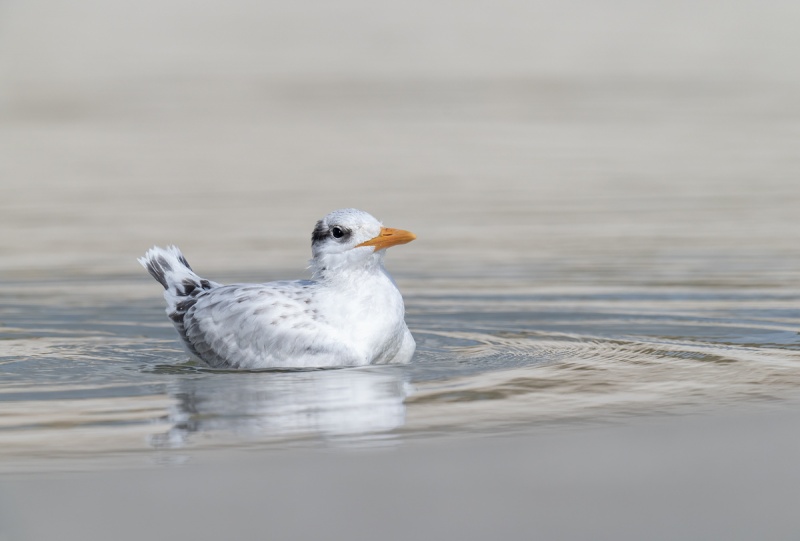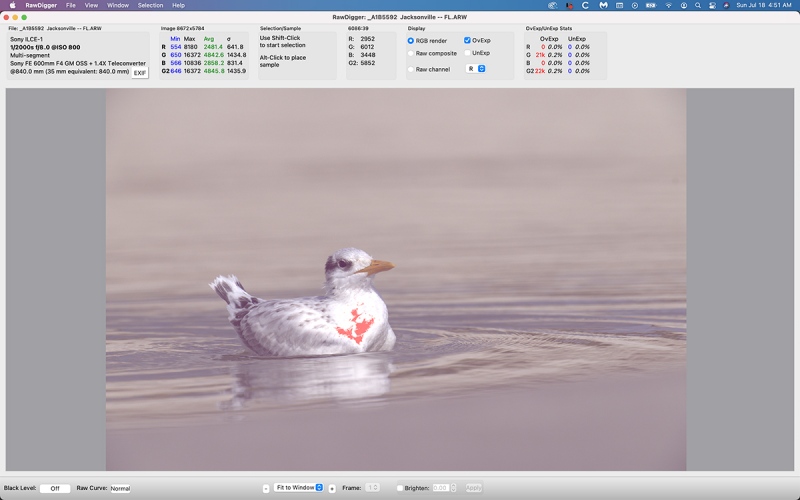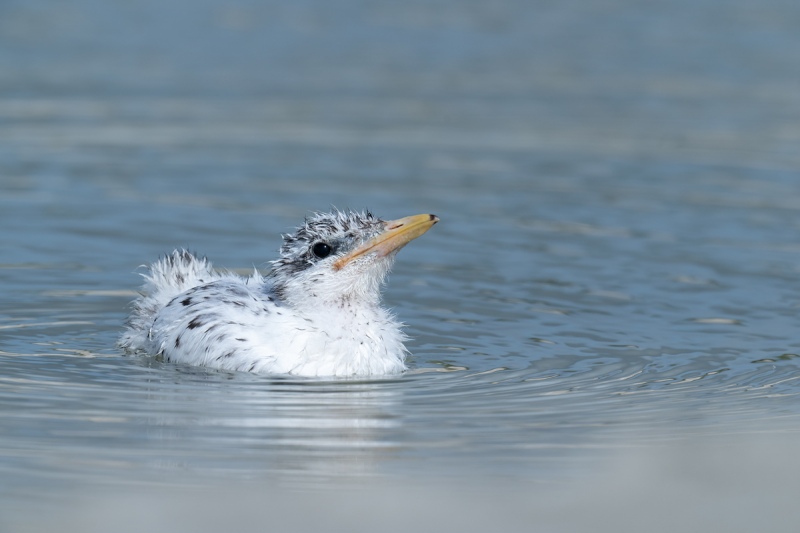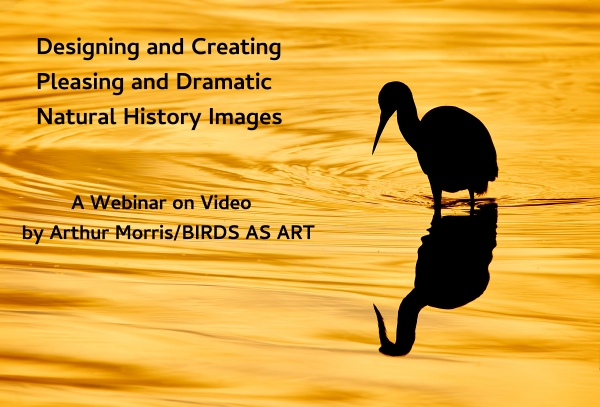Your Fave?
Please take a moment to leave a comment; let us know which of today’s two featured images you like best, and why you made your choice.
What’s Up?
Though the weather has been a challenge — nothing but sun all day every day, with a slight breeze from the southwest early each morning and a strong southeast wind in the afternoons, everyone has gotten lots of great images. On Saturday morning the wind switched to southeast earlier than it had on Friday so we had lots of more excellent flight photography. Again, we enjoyed some gorgeous clouds in the low western sky. At one point, I did head shots with the hand held 200-600 and the 2X teleconverter just to show that it can be done. Not surprising, Bird- Eye/Face tracking worked perfectly. Images soon.
Saturday afternoon was more of the same; we had a hard south wind blowing right at the bright sun. None-the-less, we had some success by sitting near the wash-over pool with long focal lengths and picking off chicks that faced us inadvertently while begging. With lots of birds right in front of us, we were getting head shots of adult and young terns until a sheriff’s vehicle with lights flashing drove slowly right through the birds while on patrol. When we got close to another group on the far side of the pool, a woman with her kid, about five, was teaching him to run through the flocks of resting birds. We left.
Today is Sunday 18 July, the last morning of the IPT. We are heading to the beach at 5:30am, and should be on the road back to ILE before noon. Wherever you are, and whatever you are doing, we hope that you too have a great day.
Remember that you can find some great photo accessories (and necessities!) on Amazon by clicking on the Stuff tab on the orange/yellow menu bar above. On a related note, it would be extremely helpful if blog-folks like me, who spend too much money on Amazon, would get in the habit of clicking on the Amazon logo link on the right side of each blog post. As you might expect, doing so will not cost you a single penny, but would be appreciated tremendously by yours truly. And it works seamlessly with your Amazon Prime account.
This blog post took more than an hour to prepare and makes 203 consecutive days with a new one. Please remember that if an item — a Delkin flash card, or a tripod head — for example, that is available from B&H and/or Bedfords, and is also available in the BAA Online Store, it would be great, and greatly appreciated if you would opt to purchase from us. We will match any price. Please remember also to use my B&H affiliate links or to save 3% at Bedfords by using the BIRDSASART discount code at checkout. Doing either often earns you free guides and/or discounts. And doing so always earns my great appreciation.
Please Remember
With income from IPTs now close to zero, please, if you enjoy and learn from the blog, remember to use one of my two affiliate programs when purchasing new gear. Doing so just might make it possible for me to avoid having to try to get a job as a Walmart greeter and will not cost you a single penny more. And if you use Bedfords and remember to enter the BIRDSASART code at checkout, you will save 3% on every order and enjoy free second-day air shipping. In these crazy times — I am out at least forty to sixty thousand dollars so far due to COVID 19 (with lots more to come) — remembering to use my B&H link or to shop at Bedfords will help me out a ton and be greatly appreciated. Overseas folks who cannot order from the US because of import fees, duties, and taxes, are invited to help out by clicking here to leave a blog thank you gift if they see fit.
New and Better Bedfords Discount Policy!
You can now save 3% on all of your Bedfords photo gear purchases by entering the BIRDSASART coupon code at checkout. Your discount will be applied to your pre-tax total. In addition, by using the code you will get 2nd day air shipping via Fed Ex.
Grab a Nikon AF-S Teleconverter TC-14E III and save $14.99. Purchase a Canon EOS R5 and your discount will be $116.97. Purchase a Sony FE 600mm f/4 GM OSS lens and save a remarkable $389.94! Your Bedford’s purchase no longer needs to be greater than $1,000.00 for you to receive a discount. The more you spend, the more you save.
Money Saving Reminder
Many have learned that if you need a hot photo item that is out of stock at B&H and would enjoy free second-day air shipping, your best bet is to click here, place an order with Bedfords, and enter the coupon code BIRDSASART at checkout. If an item is out of stock, contact Steve Elkins via e-mail or on his cell phone at (479) 381-2592 (Central time). Be sure to mention the BIRDSASART coupon code and use it for your online order to save 3% and enjoy free 2nd-day air shipping. Steve has been great at getting folks the hot items that are out of stock at B&H and everywhere else. The wait lists at the big stores can be a year or longer for the hard to get items. Steve will surely get you your gear long before that. For the past year, he has been helping BAA Blog folks get their hands on items like the SONY a9 ii, the SONY 200-600 G OSS lens, the Canon EOS R5, the Canon RF 100-500mm lens, and the Nikon 500mm PF. Steve is personable, helpful, and eager to please.


Gear Questions and Advice
Too many folks attending BAA IPTs (remember those?) and dozens of photographers whom I see in the field and on BPN, are–out of ignorance–using the wrong gear, especially when it comes to tripods and more especially, tripod heads… Please know that I am always glad to answer your gear questions via e-mail
|
|
|
This image was created on 15 July 2021 late on the first morning of the second JAX IPT. While seated on wet sand using the knee-pod technique, I used the hand held Sony FE 600mm f/4 GM OSS lens with the Sony FE 1.4x Teleconverter and The One, the Sony Alpha 1 Mirrorless digital camera. ISO 800. I seriously screwed up the exposure by accidentally turning off Zebras (with ISO on the rear dial): 1/2000 sec. at f/8 (stopped down one stop) in Manual mode. AWB at 9:34am on a sunny morning. Tracking: Flexible Spot AF with Bird-Eye/Face Detection set performed perfectly. Image #1: Royal Tern large chick swimming in run-over pool |
Wind Against Sun
In the afternoons there have been lots of tern chicks in the run-over pool and they have been fairly easy to approach. But with bright sun and a strong wind from the southeast, all of the birds in the water are facing directly away from the light. And that includes swimming birds, bathing birds, and birds resting or preening on the sand and chicks waiting to get fed. With those conditions, photography at the pool is pretty much impossible. On still mornings, or those with southeast or east winds, you have a very good chance to succeed. The out-of-focus grey in the foreground of each image is the wet sand that borders the pool.
|
|
Image #1A: RawDigger screen capture for the Royal Tern large chick swimming in run-over pool image |
An Easy Over-Exposure Save
The rosy pink Ov-Exp warnings on the breast indicate that the raw file was significantly over-exposed. I had inadvertently turned off Zebras … Note, however, that all of the Ov-Exp pixels are in the G (GREEN) channel. In the RawDigger e-guide we mention that in situations where all of the Ov-Exp pixels are in a single channel, recovering such areas is easily done during the raw conversion by pulling the Exposure slider and the Highlight slider to the left as needed. Doing so restores actual detail to the Ov-Exp areas.
Note that I leveled the image and executed a small crop.
|
|
RawDigger e-Guide with Two Videos |
The RawDigger e-Guide with Two Videos
by Arthur Morris with Patrick Sparkman
The RawDigger e-Guide was created only for serious photographers who wish to get the absolute most out of their raw files.
Patrick and I began work on the guide in July 2020. At first we struggled. We asked questions. We learned about Max-G values. We could not figure out why the Max G values varied by camera system. IPT veteran Bart Deamer asked lots of questions that we could not answer. We got help from RawDigger creator Iliah Borg. We learned. In December, Patrick came up with an Adapted Histogram that allows us to evaluate the exposures and raw file brightness for all images created with all digital camera bodies from the last two decades. What we learned each time prompted three complete beginning to end re-writes.
The point of the guide is to teach you to truly expose to the mega-Expose-to-the-Right so that you will minimize noise, maximize image quality, best utilize your camera’s dynamic range, and attain the highest possible level of shadow detail in your RAW files in every situation. In addition, your properly exposed RAW files will contain more tonal information and feature the smoothest possible transitions between tones. And your optimized images will feature rich, accurate color.
We teach you why the GREEN channel is almost always the first to over-expose. We save you money by advising you which version of RawDigger you need. We teach you how to interpret the Max G values for your Canon, Nikon, and SONY camera bodies. It is very likely that the Shock-your-World section will shock you. And lastly — thanks to the technical and practical brilliance of Patrick Sparkman — we teach you a simple way to quickly and easily evaluate your exposures and raw file brightness using an Adapted RawDigger histogram.
The flower video takes you through a session where artie edits a folder of images in Capture One while checking the exposures and Max-G values in RawDigger. The Adapted Histogram video examines a series of recent images with the pink histograms and covers lots of fine points including and especially how to deal with specular highlights. The directions for setting up the Adapted Histogram are in the text.
If we priced this guide based on how much effort we put into it, it would sell it for $999.00. But as this guide will be purchased only by a limited number of serious photographers, we have priced it at $51.00. You can order yours here in the BAA Online Store.
|
|
|
This image was also created on 15 July 2021 late on the first morning of the second JAX IPT. While seated on wet sand using the knee-pod technique, I used the hand held Panning Ground Pod-mounted Sony FE 600mm f/4 GM OSS lens with the Sony FE 1.4x Teleconverter and The One, the Sony Alpha 1 Mirrorless digital camera. ISO 500. The exposure was determined via Zebras with ISO on the rear dial: 1/2000 sec. at f/10 (stopped down 1 2/3 stops) in Manual mode. AWB at 9:50am on a sunny morning. Tracking: Flexible Spot AF with Bird-Eye/Face Detection set performed perfectly. Image #2: Royal Tern small chick swimming in run-over pool |
More Difficult Butt-Advancing …
As this bird was smaller than the chick in Image #1, and was swimming toward a steeper bank on the edge of the pool, I needed to scootch forward to get over the bank (and right, to stay on sun angle). As noted previously, I worked very hard that morning. One of my goals had been to photograph swimming Royal Tern chicks, so it was all worth it.
|
|
Designing and Creating Pleasing and Dramatic Natural History Images |
Designing and Creating Pleasing and Dramatic Natural History Images
A Video Webinar
In this 1 hour 28 minute plus video you will learn and be inspired. We cover everything from the very basics to the fine points. After a brief bio, the topics include Behavior, Action, Diagonal Lines, and the Cuteness Factor; Birds in Flight — The Holy Grail of Bird Photography; Mis-Framing!; Basic Image Design/HORIZONTALS: Get the subject out of the center of the frame. Basic Image Design/VERTICALS: The center of the frame is generally fine; The Importance of BACKGROUND; Isolating the Subject; Other Elements of Composition; On Getting Low; Going Wide for Bird-scapes; Super-tight!; Working in Sunny Conditions; Working in Cloudy Conditions; Working in Foggy Conditions; Working in the Shade; Working in Bad Weather; Creating Back-lit Images; Creating Silhouettes; and Creating Pleasing Blurs.
Each segment of the program consists of an average of about 15 images that will drive home the points being made, educate you, and inspire. The instructions and advice, given clearly and concisely, are based on my near-38 years of experience photographing birds with telephoto and super-telephoto lenses. And on several decades of creating educational blog posts.
This presentation is based on the webinar that I did for the South Shore Camera Club in April. You can find some of the comments below along with comments from two of the folks who viewed the webinar the night before the DeSoto IPT began.
You can order your copy of Designing and Creating Pleasing and Dramatic Natural History Images/A Video Webinar by clicking here or by calling Jim with your credit card in hand at 863-692-0906.
Typos
With all blog posts, feel free to e-mail or to leave a comment regarding any typos or errors.




















#2 Hands down winner. Bird has a great look/pose & bluer darker water suits me better.
I like #2 better. The white and black chick looks great against the blue background.
No. 2 for me. I like the position of the head, where the bird is located in the frame, the background and the details in the feathers, which to me says the bird has been bathing. Very nice photo.
I much prefer the first shot because I love bird shots best when the eyes are tack-sharp focussed and well exposed and in this regard, the first image appears far superior to me. Both are great shots, though.
I prefer image #2 as the subject stands out from the background better.
Both images appear a little bit tilted to me — am I wrong?
Love the second image as the bird has attitude!